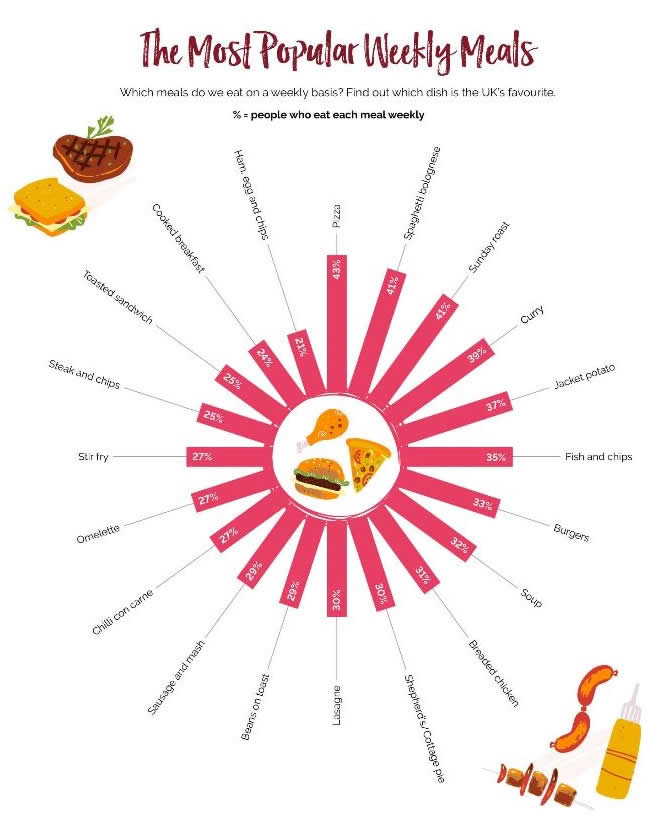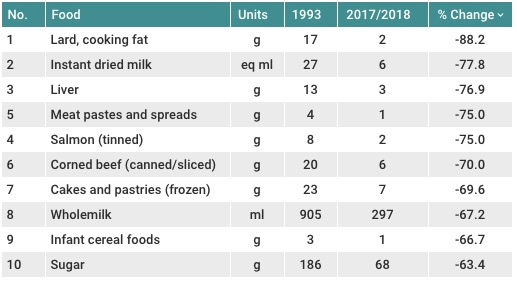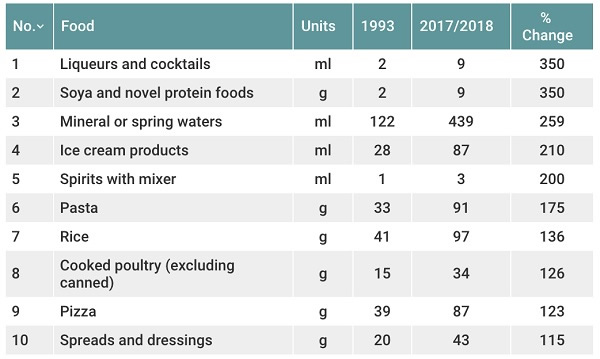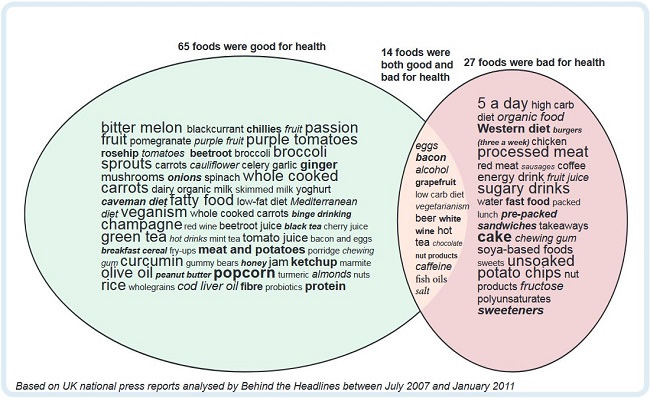Positive Health Online
Your Country

Food Trends Change over the Past 25 Years
listed in food, originally published in issue 262 - May 2020
Few of us will be shocked to read that eating habits in the UK have undergone some significant shifts since the mid-1990s. This, after all, is the very essence of trends: regardless of what triggers them, or to what extent they exert any lasting influence on wider society, the one thing they never seem to do is sit idle for very long.
In fact, the entire notion of eating habits as ‘trends’ is worthy of further distinction. In particular, it’s important to acknowledge the subtle differences between trends and norms across our entire approach to food culture. In the context of any broad overview, some food-related patterns that we might loosely label ‘trends’ are indeed just that: mercurial and fleeting, perhaps sparked by a brief ripple in pop culture, or the sudden availability of a new gadget.

https://www.leisurecooker.co.uk/uk-eating-habits
More Fundamental Change
Other sorts of adjustment in a nation’s eating habits, however, emerge over time as somehow more generational and deeply embedded. This latter category can often be aligned directly with fundamental structural change in the societies and economies that give rise to them.
Consider, for example, a recent survey-based infographic exploring UK eating habits from various angles in 2020. On the one hand, it yields several results that we might all have predicted, while others are considerably more eye-opening. Among its more predictable findings, there’s the fact that our nation’s go-to international cuisines remain Chinese, Italian and Indian. This is more or less the status quo as it stood a quarter-century ago. (All three have regularly jostled with one another for podium position in that time, but none has ever looked in serious danger of surrendering its top-three spot).

Meanwhile, the traditional Sunday roast - though still broadly viewed as a welcome indulgence - is now treated as a weekly staple by less than half of the population. The classic ‘full English’ cooked breakfast fares worse still, with fewer than a quarter of UK respondents claiming to consume one or more such meals per week. Demand for fruit and vegetables is up in general, yet we’re still eating significantly fewer of them than we should be. So far, so predictable.
While some of these habits obviously stand in stark contrast to prevailing British tastes of the 1960s-1980s, none of them necessarily represent a drastic turnabout entirely within the past 25 years. Rather, their onward march signposts us towards a far more telling group of statistics: those relating to how, rather than what, we now cook and eat as a nation.
Time-Poor, Option-Rich?
Again, it will come as little surprise to learn that, on average, we now spend less time per day sourcing and cooking our food than we’ve ever needed to before. This is one of many barriers to healthy eating that continue to impact on UK dietary decision-making.
One key driver for this has of course been the noted phenomenon of more widespread ‘time poverty’ since the turn of the century. Many of us will have been impacted to some extent by the ongoing erosion of standard ‘9 to 5’ working patterns, combined with increasingly mobile family and social lives. Planning our food shopping and meal prep around such hectic schedules demands a very different kind of balancing act than it typically did under the fading household stereotypes of yesteryear.
Moreover, continuous technological and logistical leaps during the same period have arguably exerted even greater influence. As things stand, supermarkets (both premium and, increasingly, discount chains) are heavily dominant in the consumer space, cementing a position at the very heart of UK domestic food culture that they began to establish with a vengeance in the mid-’80s. Their ability to cheaply source, process, preserve, package and transport ingredients from anywhere on the planet to our own fridge broadened exponentially throughout the 1990s, and continues apace today.

The net result has been a massive expansion in the universal availability and affordability of convenience foods over the past 25 years, turning shopping for everyday basics into a trolley dash through a truly global fast food takeout. We’ve previously covered some of the more urgent health-related downsides to an increasingly engineered food chain, although it’s worth noting that our access to (and demand for) more nutritionally balanced convenience foods has also exploded in recent years.
The problem, from a national health perspective, is that these ‘good’ dietary choices have taken far longer to establish a real foothold in the convenience market. This has long been a cause for deep and widespread concern - particularly in a UK society so strongly motivated towards preparing and consuming meals at optimal speed, with minimal effort.
How Did We Get Here?
Alarmist articles have regularly blamed our shifting culinary priorities on a modern epidemic of basic idleness, but clearly the overall picture is far more complex than that in reality. There are a vast number of contributing factors at play, many of which have in fact been reflective of hugely positive changes in society.
By the early 1990s, freezers and microwaves had become near-ubiquitous appliances in homes the length and breadth of the nation. This was convenient, absolutely - but it also heralded the arrival of a whole new era in basic food safety and hygiene standards. (As noted above, it also allowed for much improved diversity and flexibility in terms of the suppliers, ingredients, meal plans and lifestyles we wanted to build our diets around.)
Throughout the 1990s in particular, outdated societal attitudes towards the role of women as sole household caterers continued to decline steadily. At the same time, suppliers were being forced to adjust for huge surges in customer awareness around issues relating not only to diet and nutrition, but also to food ethics and environmental sustainability.

https://www.nhs.uk/news/2011/02February/Documents/BTH_Miracle_%20foods_report.pdf
As we approached the millennium, demand for alternatives to the traditional ‘meat and two veg’ staples skyrocketed, emerging in part as a response to newly revised government guidelines addressing nutritional impacts on long-term health and chronic disease. Consumers began to fully understand the profound value of more varied, better-balanced, more plant-based diets. As we travelled, socialized and dined out ever more freely, we gained knowledge and influence through exposure to a kaleidoscopic diversity of more colourful, less stodgy and less protein-dependent menus from all corners of the world.
And yet, despite all the frantic blossoming taking place across the domestic food scene during these years, one key problem remained. It was still always far easier - and often far cheaper - to sling something of questionable provenance in the microwave at the end of a long day. As we approached 2010, spending an hour or more cooking a balanced dinner from scratch looked to be an option that many of us had entirely taken off the table.
Where to Next…?
As of 2020, speed and convenience remain among our primary motivations in many of the daily culinary choices we make as a nation, both at home and when eating out. Take a glance at any supermarket ‘bestsellers’ list, and this conclusion is tough to avoid. It’s also fair to say that things are unlikely to change any time soon. (Despite a groundswell in affection for certain aspects of so-called ‘slow culture’ of late, we’re certainly not getting any less busy, either as individuals or as a society.)
With that said, though, there are numerous reasons to feel optimistic about the long-term health of the UK’s food habits at the start of this new decade. Prevailing attitudes to environmental sustainability - especially around food production, sourcing, packaging and waste - have recently appeared to enter another phase of quite rapid evolution. Overall demand for red meat continues to slow, with the relatively nascent market in plant-based substitutes already booming in contrast.
Furthermore, other socioeconomic and political challenges continue to drive renewed interest in reassessing the balance of our supply chains. This is particularly true with regards to the huge deficit in domestic fruit and vegetable production we’ve allowed to build up over the past 25 years. (Recent academic studies have shown that ‘the UK was nutrition secure over the period 1961–2011 for energy, macronutrients and key micronutrients’, but that by 2010 it was starting to become ‘reliant on imported foods to meet energy, fibre, total carbohydrate, iron, zinc and vitamin A requirements’ - a situation that we may have little choice but to address post-Brexit.)
Since 1995, motivations based on a variety of health and environmental concerns have steadily gained traction among UK shoppers and diners. This now looks to be accelerating in many areas, although there is still a good deal of work to be done on both fronts.
Meanwhile, issues relating to time, understanding and cost-effectiveness still appear to dominate in many areas of the UK food market. For as long as that remains the case, we continue to face a difficult challenge in combining more robust long-term sustainability with healthier eating habits moving forward.
Comments:
-
No Article Comments available